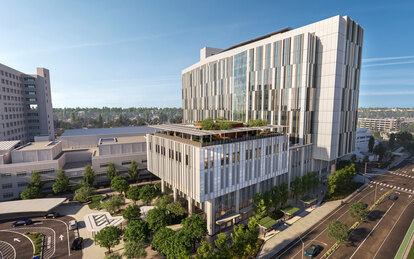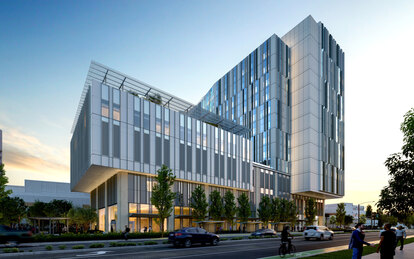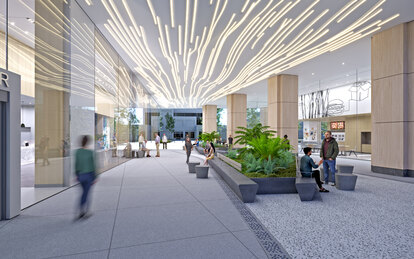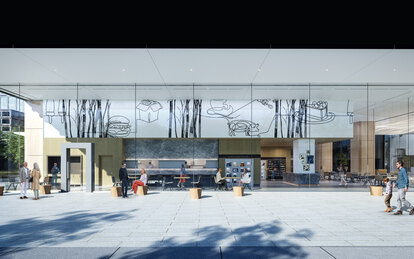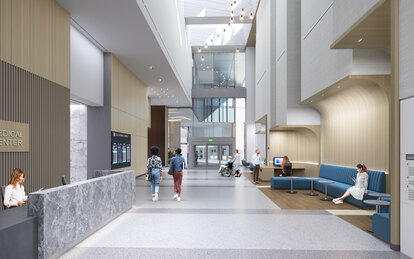UC Davis Health California Tower
A major expansion substantially increases critical care capabilities at this public hospital and ensures a healthcare safety net for marginalized populations in California’s Central Valley.
Client
University of California, Davis Health System
Location
Sacramento, California
Markets/Services
Academic Medicine, Acute Care, Architecture, Health, Interiors, Lighting Design, Medical Planning, Sustainable Design
Size
910,000
Featured Awards
The American Institute of Architects (AIA) Healthcare Design Award, Unbuilt, 2024
UC Davis Health (UCDH) is executing the largest health system capital program in the U.S. today, making a $7.5 billion investment to transform its healthcare platform for a changing future. The transformation program includes the California Tower bed expansion and the 48X Complex, an advanced outpatient surgery center, also planned and designed by SmithGroup.
UC Davis Health, a public hospital serving the Sacramento region for more than 150 years, is working to expand and update the campus to meet the region’s needs for the next 50 years, while removing barriers to health equity for vulnerable residents. It wanted a building that would be iconic but not extravagant, expressing the high quality of care provided and their longstanding commitment to the community.
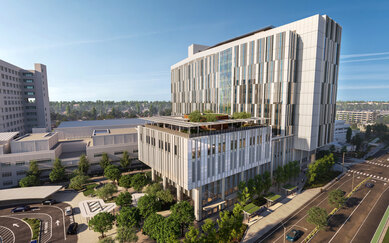
The Tower expresses diversity through a tapestry of vertical fins in varying shades of gray that mitigate solar exposure; at a subtle bend in the tower, 10-story glass art installations on the east and west facades create colorful ‘hinges’ that further celebrate the idea of diversity and discovery.
Comprising a 14-story hospital and 5-story pavilion, the California Tower reflects UCDH’s devotion to patient care, community health, research and education. It is the most advanced hospital in the region, designed to create a cornerstone for critical care that emphasizes adaptability to surge events and advancing medical technologies. The building integrates seamlessly into its urban neighborhood, offering inclusive spaces and public-oriented programming. It embodies its central design concept, “Confluence,” which speaks to the coming together of its richly diverse community and the confluence of two rivers that form the region’s distinctive topography.
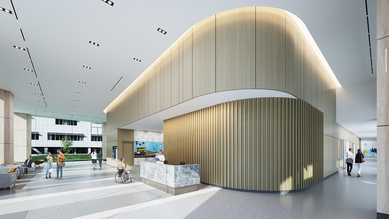
Upon entering the facility, patients and visitors are greeted with a welcoming and open lobby.
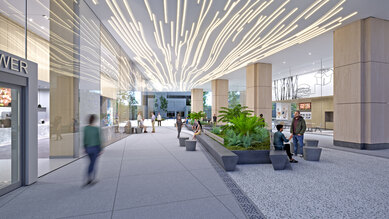
At the street level, expansive areas of glass, courtyards and a breezeway create a sense of permeability, improving the pedestrian experience and encouraging movement through and around the building. The two-story breezeway connects the public realm to the main hospital tower entrance and the pavilion, blurring the line between hospital and community.
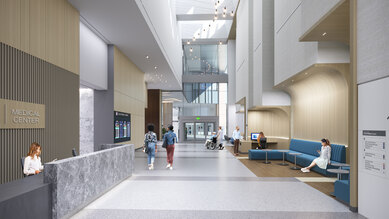
The building’s interior architecture is centered around providing a serene and healthful environment that is attentive to diverse needs and cultural perspectives.
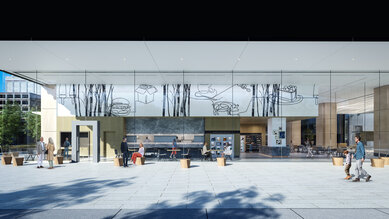
The design creates several indoor and outdoor spaces designed to draw patients, staff and the public together, including a Family Resource Center, health education areas, courtyards and a 10,000-square-foot garden atop the pavilion, and a public art program celebrating the community’s diversity, fostering connection and the exchange of ideas.
Informed by an extensive pre-design Hospital of the Future study, the California Tower houses patient units, an integrated surgery and procedure platform, a Level 1 trauma emergency department, burn care unit, pharmacies and graduate medical education spaces. The new tower significantly increases the hospital’s ICU capability, with 240 acuity-adaptable patient rooms licensed and operated as med-surg or more intensive care nursing.
A pioneering Pandemic Mode patient room concept provides additional airborne infection isolation capabilities through negative-pressure rooms that can be quickly activated to isolate outbreaks. These highly versatile patient rooms are engineered to seamlessly switch on demand between normal and emergency surge operations without requiring reconstruction or temporary mobile equipment. This innovation eliminates the need for emergency approvals and increases UCDH’s isolation-capable rooms tenfold.
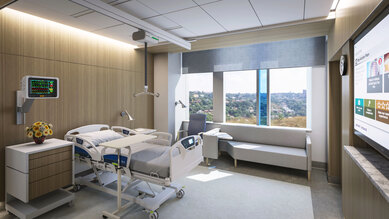
Based on research by the UC Davis California Lighting Technology Center, which is working to minimize circadian rhythm disruptions for shift workers and patients, the California Tower will be one of the first in the country to use a full portfolio of circadian lighting using an energy-saving LED lighting system.
In developing this new class of patient room, the California Tower design team has given us one of the most flexible buildings we’ve ever seen. UC Davis can adapt to the unforeseeable impacts of infectious diseases by increasing our capacity and preparedness. Our world-class healthcare system can continue to provide the best care in a safe environment with little disruption to our operations, even in a crisis. It’s a game changer.
Jill Tomczyk
Executive Director of Strategic Programs, UC Davis Health System
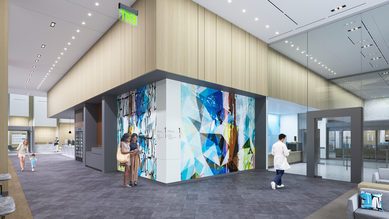
The North Lobby features community art throughout the space. UC Davis Health works with art consultants to reinforce the concept of diversity in its art installations. The work of diverse local artists will be included throughout the interior.
The design of the UC Davis California Tower advances climate action measures for a challenging building type, setting the stage for a near-term transition to net zero energy and carbon. Key energy efficiency measures include LED lighting, decoupled OR systems, airflow setbacks, heat recovery dishwashers, variable flow kitchen hoods, and heat recovery chillers. The project targets LEED Gold, with sustainable practices prioritizing cleanability, infection control, and durability, using toxin-free materials and locally sourced, recyclable options.
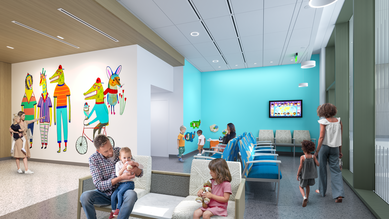
The emergency department has a designated pediatric waiting area that offers natural light, playful wall graphics, and a kid’s play area for children to actively engage and freely play, while also providing a positive distraction for family members.
The project evolved in close cooperation with the community. Fulfilling UC Davis Health’s mission as an anchor institution, the project team developed partnerships with community-based organizations, neighborhood associations and business programs to ensure that the California Tower uplifts the community, especially in traditionally underrepresented areas. The project is intended as a development catalyst, replacing a surface parking lot with an important community asset that provides jobs and fuels community wealth-building. Most of all, the California Tower provides needed specialty medical services and a robust healthcare safety net—building on a 150-year legacy of improving health outcomes for area residents.
